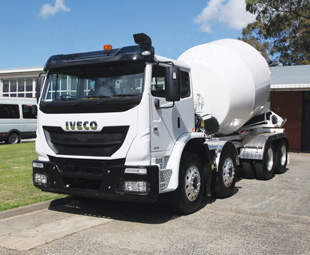ACCO still goes on …

In his monthly review of global news for local truckers, FRANK BEETON revisits the continuing ACCO story, positions and details Eaton’s new dual-clutch transmission, and measures the recent success of European vans in North America.
Many of our readers will remember the International ACCO as a charmingly ugly, but nevertheless effective, transportation device, which first appeared on South African roads in 1970. This truck had its origins in the AACO series of vehicles, designed by International Harvester for the Australian army in the 1950s.
Designated ACCO (Australian Model C Cab Over), this was unique in combining United States (US)-style truck engineering with the forward control cab configuration preferred by Australian operators.
The range was extremely successful, and survived the demise of International Harvester (IH) per se in 1986, to continue under the Iveco banner, after IH’s Australian assets were acquired by the Italian manufacturer in 1992.
Having obtained the rights to the ACCO line, Iveco Trucks Australia continued to manufacture and market these models successfully, and rebranded them as “Iveco” products in 2002.
Support for the ACCO from the waste handling industry, in particular, has been very strong. Its combination of basic engineering, well-developed dual control (left and right-hand steering), and appropriate configuration availability has been well-appreciated in that sector.
The current basic design dates back to 1972, but has received progressive facelifts and updates to keep track of evolving market trends. Total production of the ACCO series has now exceeded 78 000 units.
The most recent update of the ACCO range was unveiled at the end of 2014, with facial features clearly resembling Iveco’s latest generation of mainstream European-sourced products. The current ACCO is the only truck built completely in Australia; with its cab panels being pressed in the Dandenong plant and local companies supplying many of its component parts to provide a local content of more than 85 percent.
The range consists of 4×2, 6×4 and 8×4 derivatives, with a maximum gross vehicle mass (GVM) or gross combination mass (GCM) rating of 30 t. It is powered by the Euro-5, 8,9-litre, Cummins ISL diesel engine, with available ratings of 210, 240 or 255 kW (280, 320 or 340 hp) and torque outputs of up to 1 500 Nm.
The standard transmission fitment is Allison’s six-speed, generation-five, fully automatic unit. The ABS employs drum brakes all round, and various Hendrickson parabolic steel leaf, air or rubber suspension systems can be specified.
Rear-drive axles are sourced from Meritor, and can be fitted with driver-controlled differential locks. The agitator (truck mixer) models are equipped with electronic stability control, and all models have both engine and transmission-driven power take-offs (PTOs).
Inevitably, questions are frequently posed about ACCO’s potential for further survival. It is generally accepted that relatively low-volume models with high percentages of unique parts do not sit comfortably with global truck manufacturers looking for the broadest spread of cost amortisation across their markets.
ACCO has survived thus far because it fits the evolving requirements of its market so well, has been thoroughly developed and tested over many years, and is marketed by enthusiasts who believe in it.
In some ways it presents as a refreshing change from those state-of-the-art products of the global industry whose appearance has been shaped by the evolution of aerodynamic understanding, and now appear somewhat over-styled as a result. Fleet engineers, no doubt, love the ACCO’s simple lines, which must be a cost-effective joy when minor impact damage needs to be repaired.
Notably, production-line detail preparation for final bodywork fitment is another ACCO standard feature intended to ensure reliability, and must, in its own right, be a powerful argument for its continuing support by customers.
Eaton Joins the Dual-Clutch Club
The initial one-and-a-half decades of the 21st century have witnessed a veritable explosion in the application of electronics-based technology in all types of motor vehicles, including trucks and buses.
Possibly the most significant application of electronic wizardry, introduced into commercial vehicles during this period, has been the increasingly wide adoption of Automated Mechanical Transmissions (AMT).
 In 2010, Daimler-controlled Mitsubishi Fuso Truck and Bus Corporation introduced an alternative technique into the commercial AMT field with its Duonic six-speed, dual-clutch transmission. Installed on the new Canter LIFT light-truck product range, MFTB added some special features to make the dual-clutch concept suitable for commercial use; including a park facility, non-wearing wet clutches, and a low-speed creep/hill-hold function.
In 2010, Daimler-controlled Mitsubishi Fuso Truck and Bus Corporation introduced an alternative technique into the commercial AMT field with its Duonic six-speed, dual-clutch transmission. Installed on the new Canter LIFT light-truck product range, MFTB added some special features to make the dual-clutch concept suitable for commercial use; including a park facility, non-wearing wet clutches, and a low-speed creep/hill-hold function.
During 2014, Volvo moved the dual-clutch technology into the heavy-duty arena with its 12-speed, SPO 2812 I-Shift dual-clutch unit. Apart from size and input torque capacity, this unit differed from previous dual-clutch applications in that it also featured a range-change facility.
The obvious size gap left between the Canter and Volvo installations has now been filled by Eaton, with its Procision seven-speed dual-clutch transmission. Available mid-2015 initially for US Class six and seven trucks (GVM ratings from 8 864 to 15 000 kg), it will later feature in global applications. This unit has an input torque limitation of 895 Nm, and can be installed behind engines such as the Cummins ISB with outputs of up to around 225 kW (300 hp).
Features include: low-speed manoeuvring facilities; automatic selection of economy or performance profiles prompted by grade, vehicle mass and throttle inputs; hill-hold, which mitigates against roll-back or roll-forward for up to three seconds on grades with slopes of up to eight percent; three standard PTO openings; and brake-pedal activated downshifts to improve speed control on downgrades.
The design life of this transmission is ten years or the equivalent of 640 000 km, and the use of synthetic transmission fluid enables filter and lubricating fluid change intervals of 240 000 km.
The launch publicity clearly identifies torque-converter automatic transmissions as the marketing targets of the Eaton Procision. The manufacturer claims an “eight- to ten-percent or greater” fuel-economy benefit over the traditional automatic alternative, and stresses the ease with which this unit can be tailored and customised for specific applications.
Judging by the rapid acceptance of the AMT facility in the South African market, we believe that the availability of a propriety unit of this type will be welcomed by those vehicle suppliers who are not able to source a suitable aggregate from their own manufacturing operations, and, once available internationally, it could find ready acceptance in the local market.
European Vans Shake Up the US Market
One of our favourite topics over the past few years has been the migration of European integral vans across the North Atlantic. One of the reasons for our interest is a long-held opinion that the US market would most likely benefit from shedding its ingrained preference for “different” products, when much of the world can quite happily get by with vehicles that follow more universally accepted design criteria.
 We have seen some progress being made, with the gradual uptake of “in-house” diesel engines in the heavy truck market, where the likes of Daimler (Freightliner/Western Star), Paccar (Kenworth/Peterbilt) and Volvo (including Mack), have convinced increasing numbers of American operators to specify their own power units.
We have seen some progress being made, with the gradual uptake of “in-house” diesel engines in the heavy truck market, where the likes of Daimler (Freightliner/Western Star), Paccar (Kenworth/Peterbilt) and Volvo (including Mack), have convinced increasing numbers of American operators to specify their own power units.
The truckers’ solid refusal to accept anything other than “conventional” (bonneted) cabs remains steadfast, though, while the quirky mix of bonneted cabs and petrol engines that dominates the medium-duty truck sector still prevails.
To be fair, the European vans that have made the transatlantic trip have not been totally immune to Americanisation, in terms of power unit choice or branding. Mercedes-Benz, which started the “Eurovan to America” ball rolling in 2001 with its Sprinter range, used local Freightliner and Dodge branding to spread its appeal (although the latter disappeared after the dissolution of DaimlerChrysler) and has also fitted a petrol engine into the newly announced Vito spin-off, marketed as Metris in America.
Fiat Chrysler Automobiles renamed the Ducato as the Ram ProMaster for the US market, and has followed up with the Doblo-based ProMaster City, having inserted Chrysler’s Tigershark 2,4-litre 24-valve petrol engine in place of the diesel powerplant used in Europe.
Nissan went the route of developing a unique full-bonnetted large van for America; the NV1500/2500/3500 series, powered by 4,0-litre petrol V6 or 5,6-litre V8 petrol engines. It also brought in the smaller NV200 from Europe, fitted with a larger 2,0-litre four-cylinder petrol engine to suit American tastes. It is also selling a Chevrolet-branded version to General Motors for distribution through its own dealer network.
Finally, Ford added a 3,5-litre EcoBoost petrol unit option to its European Transit family (normally powered by a 2,2-litre diesel) for North America, and has been pushing the lighter Transit Connect range heavily in that market.
When the results of the US vehicle market for the first quarter of 2015 were published, it was interesting to see how these European-type vehicles were doing. In the “small commercial van” segment, the Ford Transit Connect, which had first defined and created the category in 2009, held a 55,5-percent share, followed by the Nissan NV200 (19-percent share), Ram’s Chrysler Voyager-based Cargo Van (12,8 percent), Chevrolet City Express (9,1 percent) and Ram ProMaster City (3,5 percent).
In the “large commercial van” segment, Ford’s Transit held top spot with 33,9 percent penetration, followed by its older US-designed Econoline (20,6 percent), Chevrolet’s US-designed Express (15,6 percent), the Mercedes-Benz Sprinter (8,3 percent), Ram ProMaster (8,2 percent), GMC’s US-designed Savana (7,8 percent), and Nissan’s NV Series (5,5 percent).
In this heavier category, European-type vehicles accounted for a cumulative market share of 50,4 percent, while the “traditional” US types, plus Nissan’s unique North American NV Series, made up the balance.
Clearly, the European vans dominate the smaller segment, and have achieved the majority share in the larger category. Production of “traditional” US types is set to decline further, with the Ford Econoline down from 38 000 units in 2015 to 22 000 in 2016, and GM’s Express and Savanna GMT610 platform down from 103 100 units to 93 000 over the same period, while the Ram Cargo Van is expected to run out at the end of 2016.
This suggests that the market share of the European vans will increase further, and it will be interesting to see if GM will look for an equivalent heavy van product (in Europe, GM’s Vauxhall and Opel brands are partners with Renault and Nissan in two van programmes).
Another moot point is how long Nissan will persevere with its American NV series while it is being comfortably outsold by proper European-style products, so there could be a potential common solution to the dilemmas of both the Nissan and GM.
Global FOCUS is a monthly update of international news relating to the commercial vehicle industry. It is compiled exclusively for FOCUS by Frank Beeton of Econometrix.
Published by
Focus on Transport
focusmagsa




